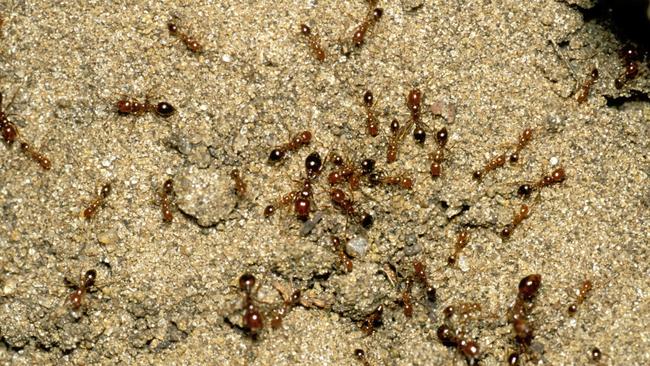Fire ants wreak havoc on southeast Qld tourism haven
More than 100 fire ants nests have been found on North Stradbroke Island, with the major incursion of the aggressive and deadly pest labelled “critical”.
QLD News
Don't miss out on the headlines from QLD News. Followed categories will be added to My News.
More than 100 fire ants nests have been located in the tourism hotspot of North Stradbroke Island, with the major incursion of the aggressive and deadly pest labelled critical by traditional owners.
The detection comes eight months after 21 nests of fire ants were located on North Stradbroke Island, also known as Minjerribah, for the first time in mid-January.
The National Fire Ant Eradication Program initially confirmed “several new nests” had been located in the tourism hub outside of the initial three hot spots, later specifying “more than a hundred” nests had indeed been located.
Fire ants were initially found mainly on former sand mining leases on the island, but the department said the location of the new nests couldn’t be disclosed for “privacy reasons”.
“However it is not in a public access area and therefore poses minimal risk to community safety,” a spokesman said.
Quandamooka Yoolooburrabee Aboriginal Corporation (QYAC) chief executive Stephen Wright said traditional owners had been “extremely concerned” about fire ants before they were detected on the island, and the issue was now “critical”.
“QYAC remains concerned that the scale of the fire ant threat is growing,” he said.
“We will continue to press DAF (Department of Agriculture and Fisheries) to do more, and we will continue to participate fully in all attempts to eradicate fire ants from Minjerribah.”
Mr Wright said QYAC had marshalled its resources to work collaboratively with DAF to “respond strongly” to the fire ant threat.
The department also confirmed fire ants were detected in Morayfield during “routine surveillance activities” in August, with all nests destroyed.
Invasive Species Council (ISC) spokesman Reece Pianta said the location of fire ants on Minjerribah, at Morayfield and on the southern Gold Coast proved the pests’ population was surging.

And while eradication was still “possible” proper funding particularly by the federal government was necessary.
It was recently revealed Australia’s latest battle plan against a destructive super pest will involve less money than expected, slashing the treatment area in half, and reducing surveillance efforts.
Slow bureaucracy is largely to blame for the funding shortfall this financial year, according to the ISC, warning any “dithering and delay” risked failure in the fight against the deadly and industry-decimating red imported fire ant.
Federal Agriculture Minister Murray Watt in August affirmed the Commonwealth was “100 per cent” committed to fire ant eradication and he was working to secure long-term funding beyond June 2024 for the program.
The Red Imported Fire Ant, native to South America, was first detected in Queensland in 2001. Previous estimates have put the ant’s estimated cost to the economy at $1.65bn a year if spread was uncontained.





